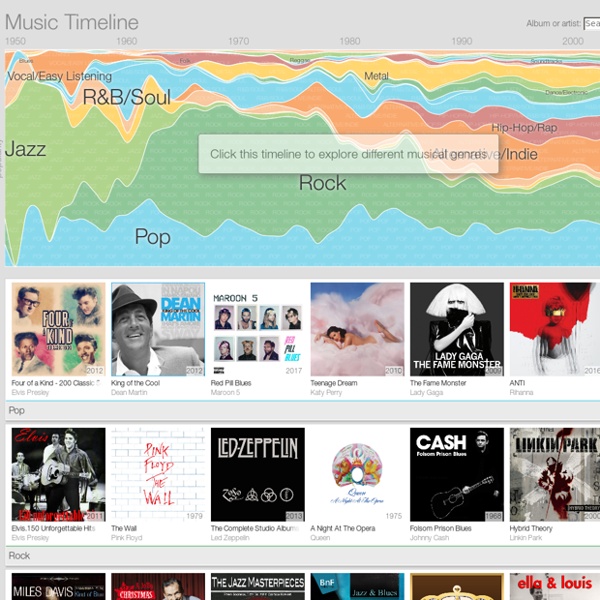



https://music-timeline.appspot.com/#
Related: Timeline tools and resources. • musik web, blog,.. • MUSICCivil Rights Movement Timeline (14th Amendment, 1964 Act, Human Rights Law) Jan. 23 The 24th Amendment abolishes the poll tax, which originally had been instituted in 11 southern states after Reconstruction to make it difficult for poor blacks to vote. Summer
How to write a hit: structure The most common and accessible pop song format to evolve over the last 50 years is made up of the holy trinity of verse, chorus and middle 8. Referred to as ABABCBB, in practice, it goes like this: intro/verse1/chorus1/verse2/chorus2/middle 8/chorus 3/chorus out. With modern production tricks, this classic skeleton is beginning to evaporate into a simpler framework containing just a verse and a chorus, with variety being created by the sounds of the parts rather than the parts themselves being different. In other words, there's more sonic variety than musical variety. The use of filters, in particular, has encouraged repetition of parts that would otherwise become boring.
List of timelines From Wikipedia, the free encyclopedia This is a list of timelines currently on Wikipedia. §Types[edit] §General timelines[edit] §History[edit] Find Music Rise from the Ashes Event skip Not logged in Log In Geologic time scale Online exhibits Geologic time scale Take a journey back through the history of the Earth — jump to a specific time period using the time scale below and examine ancient life, climates, and geography. You might wish to start in the Cenozoic Era (65.5 million years ago to the present) and work back through time, or start with Hadean time (4.6 to 4 billion years ago)* and journey forward to the present day — it's your choice. [Note: "mya" means "millions of years ago"] Ways to begin your exploration:
5 Tools Students Can Use to Create Music Online Online music creation tools can be used by students to make music to use in projects like podcasts and videos. Students can also use online music creation tools to experiment with rhythms and sounds to learn how music is made. The following free tools can be used for either of those purposes.Soundtrap is a fantastic tool for creating music online. Brief Timeline of American Literature and Events, 1620-1920 Brief Timeline of American Literature and Events: Pre-1620 to 1920 This timeline provides a short chronology of events in American history and literature. It is linked to course pages and bibliographies as well as to a set of more general linked resources: pages on American authors, literary movements, and American literature sites. Each author page contains a picture (if available), a bibliography (if available), links to major sites about the author, and links to works online.
Music Express Magazine Recommended Play all 13:21 5:44 5:27 5:04 2:00 Splash! - Duration: 2 minutes. This item has been hidden May/June 2016 Play all Choreography and lesson videos for selected content from the May/June 2016 issue of John Jacobson's Music Express Magazine, www.musicexpressmagazine.com. 6:45 13:59 2:00 Splash! - Duration: 2 minutes. 5:44 This item has been hidden March/April 2016 Play all Choreography and lesson videos for selected content from the March/April 2016 issue of John Jacobson's Music Express Magazine, www.musicexpressmagazine.com. 2:09 Shine! - Duration: 2 minutes, 9 seconds. 6:26 1:55 10:22 13:17 5:27 This item has been hidden January/February 2016 Play all Choreography and lesson videos for selected content from the January/February 2016 issue of John Jacobson's Music Express Magazine, www.musicexpressmagazine.com.
Folk Music of England, Scotland, Ireland, Wales & America Welcome to Lesley Nelson-Burns' (aka the Contemplator)'s Folk Music Site.Folk and Traditional Music and Popular Songs, with Lyrics, Midi, Tune Information and History behind the folksongs and ballads. Irish, British and American Folk Music including Francis J. Child Ballads and Sea Shanties.